Database Reference
In-Depth Information
Figure 8-13. Currency formatting offers four choices for the placement of the currency symbol (a
dollar sign in this example). The first option leaves it out entirely. The second and third place it be-
fore the number and before or after the negative symbol if present. The final option places the cur-
rency symbol immediately after the number.
As Entered
When you choose “As entered” from the Format pop-up menu, FileMaker shows the date
al-
most
the same way you type it. If you type a two-digit year, the program changes it to four
digits. Otherwise, it leaves the data alone.
Preset Styles
The next six choices in the Format pop-up menu offer the most common ways dates are
formatted, as shown in
Figure 8-14
.
Custom
For the ultimate in control, choose Custom. When you do, a bevy of menus and boxes appear
(
Figure 8-15
). By selecting different parts of a date from the pop-up menus and adding your
own text as appropriate to the boxes, you tell FileMaker exactly how you want the date
formatted. You use this option when none of the preset formats are exactly right. For ex-
ample, if you're in the United States, FileMaker suggests date formats that follow typical
U.S. standards (month, then day, then year). But if people in England use your database, you


